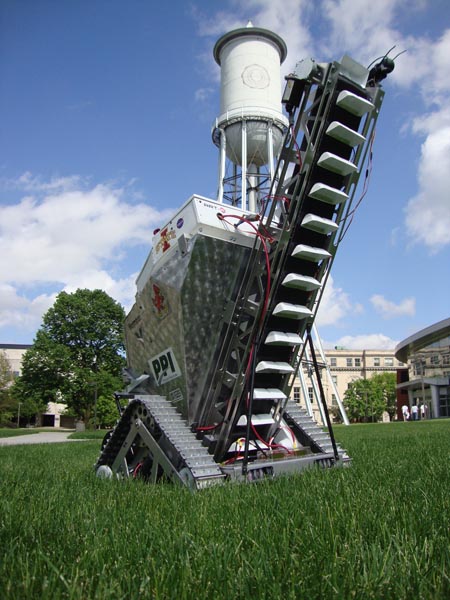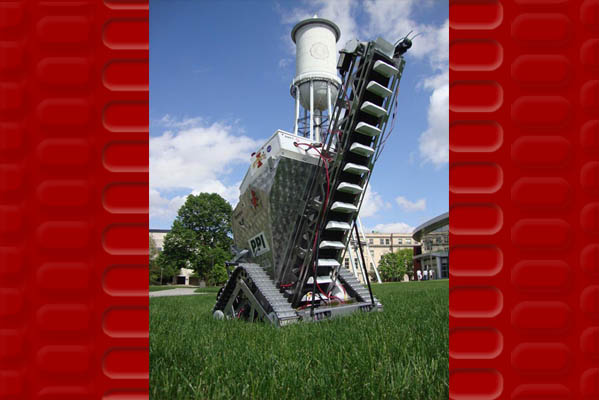By Rick Hanton, Iowa State Lunabotics Team member and Chairman of SEDS-USA
 On May 21, 2011, a group of 14 Iowa State students and their advisor began a 1,400 mile journey from Ames, Iowa, to the Space Coast in Florida. The group, known as Team LunaCY, had just finished designing and building a 175 pound moon-mining robot in Hoover Hall, and was headed to compete for the second time in the NASA Lunabotics competition at the Kennedy Space Center. The competition is open to university teams across the globe, challenging them to design and build lunar rovers able to excavate soil on the moon’s surface, called regolith, via remote control.
On May 21, 2011, a group of 14 Iowa State students and their advisor began a 1,400 mile journey from Ames, Iowa, to the Space Coast in Florida. The group, known as Team LunaCY, had just finished designing and building a 175 pound moon-mining robot in Hoover Hall, and was headed to compete for the second time in the NASA Lunabotics competition at the Kennedy Space Center. The competition is open to university teams across the globe, challenging them to design and build lunar rovers able to excavate soil on the moon’s surface, called regolith, via remote control.
Iowa State’s entry, ART-E II, was one of the few robots at the competition using a snow blower collection system to bring regolith into its hopper. The robot then offloads the regolith via its long conveyor belt into NASA’s meter-high collection bin. In competition, the main objective is to get as much regolith in the bin as possible during a 15-minute round, so ART-E had to work quickly and efficiently—a challenging task when dealing with lunar regolith, a super-fine material that can clog gears, bind chains, and block the operator’s vision when it blows into the air.
Back in 2010, the team, like most teams that year, did not get any regolith into the bin. This year, Team LunaCY returned with new tracks that used belts rather than chains; and improved the impeller design; an offload conveyor that now used buckets; and a redesigned hopper with vibrators, vents, and a motorized door to help the regolith flow out when needed. Because much of these design developments were done after classes and homework, they weren’t perfected until just a few weeks before the competition, giving the team only a month to turn a pile of aluminum, rubber, plastic, and electronics into a working robot.
The students did manage to finish the robot just a few days before heading to Florida. They completed the electronics in their hotel rooms, along with some other last minute tweaking. On the competition day, the team’s robot easily rolled out of the starting position and began a series of runs back and forth across the sandbox to collect regolith, but after the second turn, ART-E became stuck.
One of the tracks had popped off of its roller bogey after the bolt vibrated out. Still, the driver turned using his remaining track to pick up more regolith and then went through a dump sequence, dumping nearly 90 pounds of regolith back into the sandbox. After continuing its paralyzed digging, the robot lost its other track and the competition run was done for Iowa State—with no regolith officially collected.
The Iowa State team was disappointed but not ready to give up on their design. They fixed the mechanical problems and prepared for a non-competition demonstration a few days later. During that round, the robot didn’t break and the team’s new tracks amazed the judges. The team managed to collect and dump 31.7 pounds of regolith in the bin, a qualifying amount, but much less than the 522 pounds collected by the first place team from Laurentian University (Ontario, Canada).
Even though Team LunaCY did not bring home any awards from the competition, they are already making plans to compete again next year. Lessons learned this year will be shared with new members as design and testing begin on ART-E III during the new fall semester. In the tradition of Cyclone spirit, the team will return with an even better robot to mine enough material to take the prize and maybe someday see their design actually used on the moon.
Read more about the ups and downs of Team LunaCY’s competition on INNOVATEonline.
